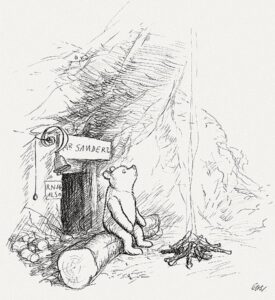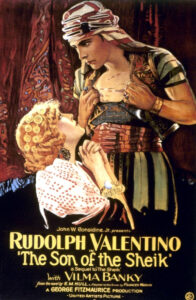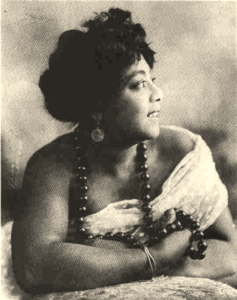Works from 1926 are now open to all, as is a cornucopia of recorded music: An estimated 400,000 sound recordings from before 1923!
On January 1, 2022, copyrighted, published works from 1926 entered the US public domain, where they are now free for all to copy, share, and build upon. The lineup this year is stunning. It includes books such as A. A. Milne’s Winnie-the-Pooh, Felix Salten’s Bambi, Ernest Hemingway’s The Sun Also Rises, Langston Hughes’ The Weary Blues, and Dorothy Parker’s Enough Rope.
There are scores of silent films—including titles featuring Harold Lloyd, Buster Keaton, and Greta Garbo, famous Broadway songs, and well-known jazz standards. But that’s not all. In 2022 we get a bonus: An estimated 400,000 sound recordings from before 1923 will be entering the public domain too! (Please note that we are referring here only to US law; the copyright terms in other countries are different.)
Books
Here are just a few of the beloved and classic books that entered the public domain in 2022.

Illustration to page 3 of Winnie-the-Pooh (1926) by artist E. H. Shepard. Image in the public domain.
- A. A. Milne, Winnie-the-Pooh, decorations by E. H. Shepard
- Ernest Hemingway, The Sun Also Rises
- Dorothy Parker, Enough Rope (her first collection of poems)
- Langston Hughes, The Weary Blues
- T. E. Lawrence, The Seven Pillars of Wisdom (later adapted into the film Lawrence of Arabia)
- Felix Salten, Bambi, A Life in the Woods
- Kahlil Gibran, Sand and Foam
- Agatha Christie, The Murder of Roger Ackroyd
- Edna Ferber, Show Boat
- William Faulkner, Soldiers’ Pay (his first novel)
- Willa Cather, My Mortal Enemy
- D. H. Lawrence, The Plumed Serpent
- H. L. Mencken, Notes on Democracy
Sound Recordings
Thanks to a 2018 law called the Music Modernization Act, a special category of works—sound recordings—finally join other works in the public domain. On January 1, 2022, the gates opened for all of the recordings that have been waiting in the wings. Decades of recordings made from the advent of sound recording technology through the end of 1922—estimated at some 400,000 works—are now open for legal reuse.
What will we celebrate in 2022? Everything from experiments with nascent sound recording technology in the late 1800s to opera, classical music, early blues and jazz, vaudeville, ragtime, popular songs, and comedy sketches. With so many recordings to choose from, we can only feature a few of them here. To listen to more recordings, check out the selections from the Association for Recorded Sound Collections and go to the Library of Congress National Jukebox—in 2022 the Library of Congress will make all of the pre-1923 recordings in its collection available for download from this site, while recordings from 1923 forward will be streaming-only until they are in the public domain. As you look through the following list, note that only the pre-1923 recordings made by these artists are entering the public domain, not their later recordings.
- Mamie Smith and Her Jazz Hounds, Crazy Blues, Don’t Care Blues, That Thing Called Love, and You Can’t Keep a Good Man Down (Perry Bradford)
- Ethel Waters, Down Home Blues (Tom Delaney) and There’ll Be Some Changes Made (Benton Overstreet, Billy Higgins)
- Sophie Tucker, Some of These Days (Shelton Brooks) and Pick Me Up and Lay Me Down (Harry Ruby, Bert Kalmar)
- Norfolk Jazz & Jubilee Quartets, Jelly Roll Blues (Ferd “Jelly Roll” Morton)
- Fisk University Jubilee Quartet, Swing Low, Sweet Chariot (Traditional African-American spiritual song)
- Vess L. Ossman, Maple Leaf Rag (Scott Joplin)
- Bert Williams, Nobody and Let It Alone (Bert Williams, Alex Rogers), and Everybody Wants a Key to My Cellar (Ed Rose, Billy Baskette, Lew Pollack)
- Billy Murray, Give My Regards to Broadway and The Grand Old Rag (Flag) (George M. Cohan), Alexander’s Ragtime Band (Irving Berlin)
- Harry Lauder, Roamin’ in the Gloamin’ (Harry Lauder)
- Enrico Caruso performances from operas such as Rigoletto and La Traviata (Giuseppe Verdi), La Bohème (Giacomo Puccini), and Pagliacci (Ruggero Leoncavallo); songs such as Over There (George M. Cohan, French lyrics Louis Delamarre) and O Sole Mio (Neapolitan folk song)
- Pablo Casals, Bourée (Johann Sebastian Bach) and Dream of Love (Liebestraum) (Franz Liszt)
- Sergei Rachmaninoff, Liebesleid (Fritz Kreisler; arr. Rachmaninoff)
- Orquesta Max Dolin, La Golondrina (Narciso Serradell Sevilla)
- Ory’s Sunshine Orchestra, Ory’s Creole Trombone (Edward ‘Kid’ Ory)
- Europe’s Society Orchestra, Too Much Mustard (Cecil Macklin)
- The Sousa Band, The Star-Spangled Banner (John Stafford Smith, Francis Scott Key, arr. John Philip Sousa), Semper Fidelis and multiple other marches by John Philip Sousa
- Jules Levy, The Tale of the Bumble Bee (Gustav Luders, Frank Pixley)
- Anna Chandler, She’s Good Enough To Be Your Baby’s Mother (and She’s Good Enough To Vote With You) (Herman Paley, Alfred Bryan)
- Fanny Brice, My Man (Maurice Yvain, Jacques-Charles, Albert Willemetz, English lyrics Channing Pollock) and Second Hand Rose (Grant Clarke, James F. Hanley)
- Marion Harris, I Ain’t Got Nobody (Roger A. Graham, Spencer Williams)
- Nora Bayes, How You Gonna Keep ’Em Down on the Farm? (Joe Young, Sam M. Lewis, Walter Donaldson)
- Al Jolson, Swanee (George Gershwin, B.G. De Sylva, Irving Caesar)
- John Steel, A Pretty Girl Is Like a Melody (Irving Berlin)
- Joe Schenck and Gus Van, Carolina in the Morning (Walter Donaldson, Gus Kahn)
- Peerless Quartet, Cows May Come, and Cows May Go, but the Bull Goes On Forever (Harry Von Tilzer, Vincent Bryan)
Movies
The first four films on the list include performances by the great Harold Lloyd, Buster Keaton, Rudolph Valentino, and Greta Garbo.

Poster for the film The Son of the Sheik (1926), starring Rudolph Valentino. Image in the public domain.
Moana is a work of docufiction filmed in Samoa by Robert J. Flaherty, who made the famous 1922 film Nanook of the North. Faust is a German expressionist take on the eponymous play by Goethe. Because Goethe’s play was in the public domain, the filmmakers were free to reimagine it.
- For Heaven’s Sake (starring Harold Lloyd)
- Battling Butler (starring Buster Keaton)
- The Son of the Sheik (starring Rudolph Valentino)
- The Temptress (starring Greta Garbo)
- Moana (docufiction filmed in Samoa)
- Faust: eine deutsche Volkssage (German expressionist classic)
- So This Is Paris (based on the play Le Réveillon)
- Don Juan (first feature-length film to use the Vitaphone sound system)
Now that these works and thousands of others are in the public domain, anyone can make them available to the public, enabling access to our cultural heritage. 1926 was a long time ago, and the majority of works from that year are out of circulation. Since they are now in the public domain, anyone is now free to republish or post them online. The works listed above are just the tip of the iceberg. Many more works are waiting to be rediscovered.
This post is adapted from Public Domain Day 2022 (licensed CC BY 3.0) by Jennifer Jenkins, director of the Center for the Study of the Public Domain, Duke University School of Law.

